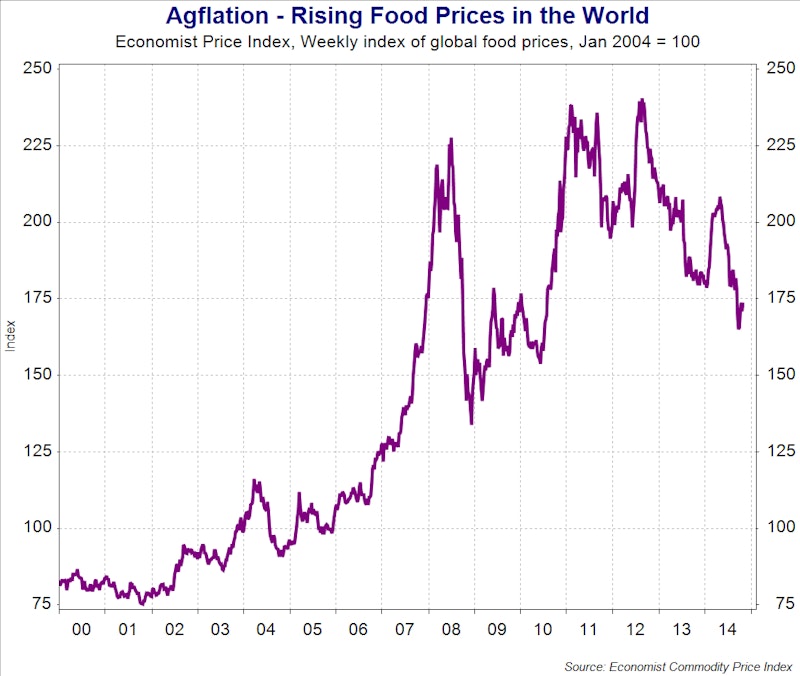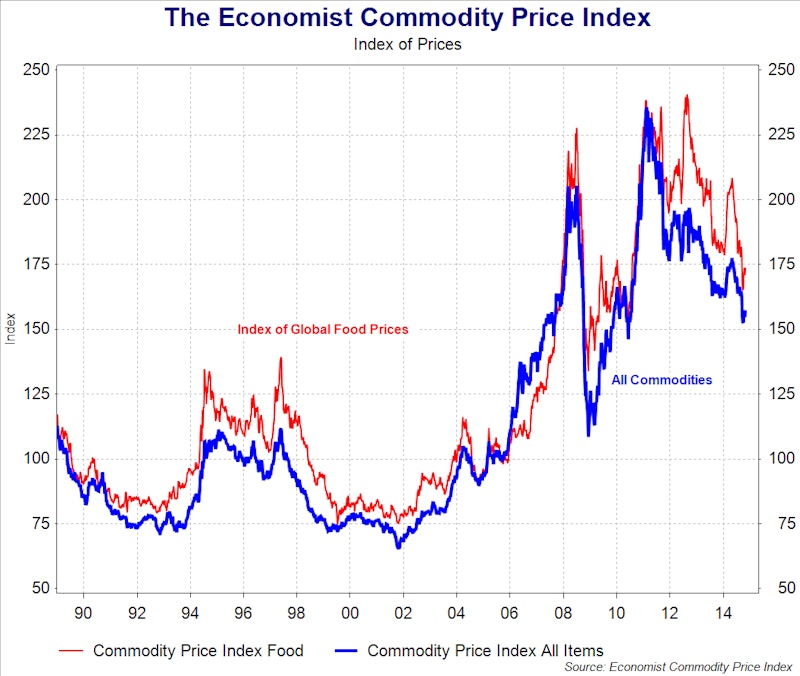Study Notes
World Food Prices
- Level:
- AS, A-Level
- Board:
- AQA, Edexcel, OCR, IB
Last updated 22 Mar 2021
In recent years there has been a significant rise in global food prices that has given rise to the term agflation

Causes of high global food prices
Many demand and supply factors have contributed to increasing prices:
- Increased bio-fuel production: Concerns over oil prices, energy security and climate change have prompted governments to encourage investment in bio-fuels. This has led to increased demand for wheat, soy, maize and palm oil, and led to a loss of resources for the food chain
- Desertification: Global warming and other environmental shifts are decreasing the quantity of available farmland by over 7 million hectares a year especially on the African continent. If global warming continues water supplies could be disrupted leading to falling food production. Deforestation, soil erosion and exhaustion are examples of the Tragedy of the Commons.
- Speculation by investors: Wheat and other prices of commodities have soared as they found favour among investors who were struggling with poor returns in other markets.
- Rising incomes: Per capita income has been rising in many emerging market countries and so too has demand for foodstuffs that have a strong positive income elasticity of demand. Producing more meat is land intensive, because you need land for the livestock and crops to feed the livestock.
- Demographics: Demand has grown because of an expanding population - the global population is expected to rise from 6 billion in 2000 to 7 billion in 2011 and 9 billion by 2050.
- Currencies: The weakness of the US dollar due to their recession increased the purchasing power of speculators and other traders who can buy increased volumes of foodstuffs with currencies other than the US dollar driving market demand to even higher levels.
- Export controls: Some food exporters limited their sales overseas so as to provide sufficient food for their own population. But whilst this helped to keep domestic prices in check it reduced supply on world markets forcing prices higher for food importers.
Economic consequences of high global food prices
- For the UK economy high food prices has contributed to a surge in inflation
- There are social and economic advantages from high food prices for example higher prices are an opportunity to improve farmers' incomes and to stimulate investments in farming.
- For developing countries that are major exporters of food, the rise in world prices helped to bring about an improvement in the terms of trade and a strong balance of payments. That said higher food prices for domestic consumers created fresh problems of poverty. And most developing nations are also dependent on importing food and other primary commodities whose prices had surged.

Social consequences of high world food prices
- Regressive effects: Lower income families spend a higher proportion of their budgets on food. Higher prices hit them hardest causing a fall in real living standards. This means that food price inflation can act like a tax on the poor and have a regressive effect on the distribution of income
- Changes in diet: More expensive food bills might cause families to switch their spending towards cheaper mass-produced processed foods that are high in salt and sugar. Malnutrition can have damaging social effects including a rise in obesity, more people suffering from Type-2 diabetes
- Deforestation and people forced off the land if countries give land to growing crops for bio-fuels.
- Social unrest: High food prices around the world led to riots in many countries especially in those economies where agflation hit the real incomes of the urban poor whose spending on food far outstripped their spending on other items. Many have died because they have been unable to survive the rise in food prices; the World Bank called this effect the 'silent tsunami.'

Food price inflation and government intervention
Agflation brought a wide number of policy responses from countries around the world. They included:
- Cash transfer payments to vulnerable households - putting extra strain on government spending and budget deficits Welfare payments have also included bread or grain subsidies specifically targeted to the poor and also rationing card systems to distribute subsidized wheat
- Rise in government spending on emergency food aid programmes and school feeding schemes
- Lower tariffs on cereal imports - the World Bank reported in 2009 that twenty-four of fifty-eight countries sampled had cut import duties and VAT in the wake of rising food inflation
- Introduction of maximum prices on bread, rice and dairy products (staple products)
- Using higher interest rates to control demand-pull and cost-push inflationary pressures
- Some countries have considered reintroducing grain buffer stock programmes to mitigate price volatility, despite the costs and problems of such policies during the 1980s and 1990s
Estimate of the impact of high food prices on poverty
According to estimates from the World Bank, the increase in local food prices between January 2005 and 2008 increased extreme poverty by between 186 and 226 million people. It has revised its previous estimate and now says that 1.4 billion people live in poverty, based on a new poverty line of $1.25 per day.
You might also like
Prebisch Singer Hypothesis
Study Notes

Copper prices collapse to a six year low
29th September 2015
Interconnected Markets - Cheap Copper
16th October 2015

World commodity prices in 2016
9th December 2016
Markets in Action - Soaring Helium Prices
Topic Videos

Commodity Prices - Cocoa Prices Surge to 40 Year High
18th January 2024

Brewed to Perfection or Priced Out? The Future of Tea
22nd July 2024